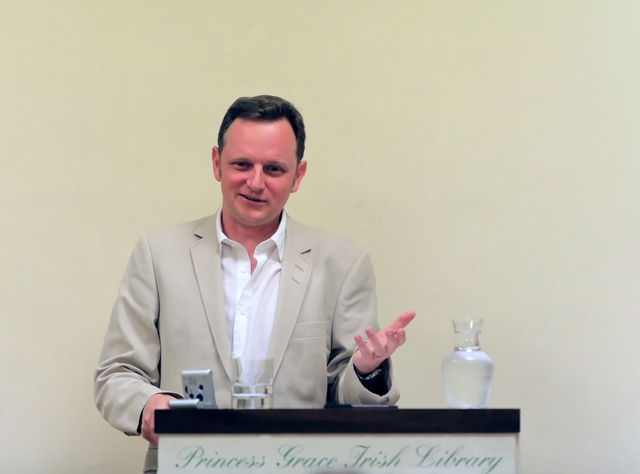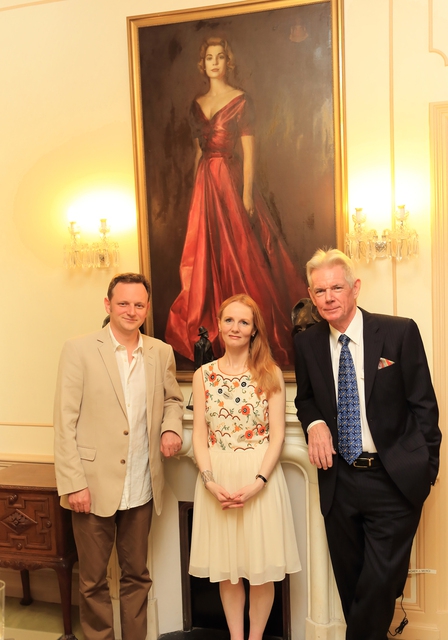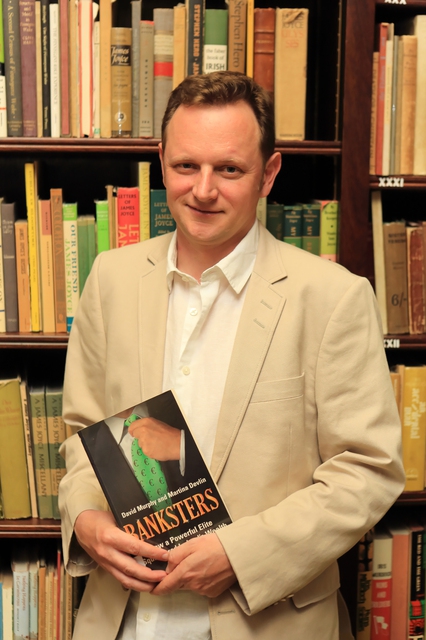
David Murphy, Business Editor, RTÉ
Journalist and author
DAVID MURPHY is Business Editor of Ireland’s public service broadcaster RTÉ. He has been at the forefront of the coverage on television and radio of Ireland’s economic rise and fall.
- Winner of Business Journalist of the Year award in 2008 and 2010 from the University College Dublin’s Smurfit Business School.
- He is co-author of the number-one best seller Banksters, a non-fiction account of the Irish banking collapse.
- He has a MSc in Economic Policy Studies from Trinity College, a MA in Journalism from Dublin City University and a BA in Spanish and Classical Civilisation from Trinity College.
David leads a dynamic team of business journalists and has spearheaded an expansion into social media and extended coverage of business and economic affairs in Ireland.
He also writes a popular blog available here http://www.rte.ie/blogs/business/author/davidmurphy/
He is a former Deputy Business Editor of Ireland’s largest newspaper - the Irish Independent.
Ireland - The Road to Recovery : Ireland has gone from Celtic tiger to humbled kitten. The country is preparing to emerge from an EU IMF loan programme. But it is left with the legacy of the most expensive bank bailout in the world and chronic unemployment and mass emigration. Despite the fallout from the crisis, many are optimistic about the outlook. But are their hopes well founded? David Murphy will analyse where Ireland went wrong, who is to blame and what can be learned from the financial collapse. He will also look into the future and analyse the prospects for a durable recovery.
Newspaper Article: ‘Even in sunny Monaco, our tax regime is seen as shady’, Martina Devlin, Independent.ie, 19 September 2013
Read full text of lecture
ROAD TO RECOVERY
When the Princess Grace Irish Library asked me for a title for this speech some time ago, I had a problem. I knew I would be talking about the Irish economy, but I really had no idea what shape Ireland would be in by the time I delivered it. So, I suggested Road to Recovery. I was trying to hedge my bets - even if the country had completely flat-lined, the title would be appropriate.
So where are we now? Well, the best way to describe the Irish economy is that it is like a man who has fallen off a tall building and has hit the ground hard. The good news is the man has stopped falling – the bad news is he is still convalescing.
The Irish Government and its diplomatic service have done a great job of telling Europe how Ireland has turned itself around.
Certainly, there are good reasons to be optimistic. However, the situation remains fragile.
The first problem is that the gap between what Ireland takes in by way of taxes and what it spends on schools, hospitals and welfare is about a billion euro a month. And that is after six years of spending cuts.
So, a lot of austerity is continuing to come down the tracks.
It was that gap between spending and taxes which made the financial markets reluctant to lend to Ireland. When they would not lend, the interest rates on Ireland’s borrowings climbed to 14 per cent. When that happened, late in 2010, the EU and the IMF stepped in with a bailout. Now, after significant cutbacks, Ireland’s cost of borrowing has dropped to four per cent.
That means the country won’t be dependent on the IMF and EU for future funds and is expected to leave the bailout at the end of this year. And it will be the first of the bailout countries to do so.
When that happens, it will be one small step for Europe’s financial stability and one giant leap for Ireland.
So what is taking place on the ground? Undoubtedly, the biggest problem is unemployment. When the crash happened, it soared from four per cent to 15 per cent. It is slowly beginning to drop and is now at 13.7 per cent.
A very big problem is personal debt. 100,000 mortgages are in arrears. Most home loans are owned by two people so that means up to 200,000 adults grappling with the threat of repossession.
For the first time since the financial collapse, jobs are being created – which is also good news. In fact, 30,000 were created over the past 12 months.
However, one of the reasons unemployment is falling is because people are leaving the country to find work elsewhere. The net emigration figure is currently 34,000 annually.
So, in a way, emigration has acted as a safety valve. Unemployment would be a lot higher were it not for people looking for work elsewhere.
For the first time, property prices are showing signs of life. The cost of residential accommodation has risen by eight per cent over the past 12 months in Dublin. But it has to be borne in mind that property has fallen by 49 per cent since the crash began in the capital.
Meanwhile, Ireland is still left with some huge problems.
The big one – a deceptively simple problem – is that it has borrowed €200 billion. That’s a lot of money in any terms, but for an economy worth €160 billion it is vast.
Indeed, the jury is still out regarding whether it can be repaid. So far, Ireland has been given the benefit of the doubt. But it is carrying an enormous burden. And without a serious burst of economic growth, it won’t be sustainable.
However, countries get over crashes. And despite the recent crisis, Ireland has come a very long way.
When I was in school in the 1980s, Ireland was a miserable place. There were queues of unemployed people, derelict sites and vacant businesses with hoardings over windows. In the North of Ireland there were hunger strikes, riots, shootings and bombs. It was no surprise people did not want to invest then.
But Ireland fixed itself. And ten years ago it was enjoying a terrific export-led boom.
Now, picture in your mind an office-worker anywhere in the world. On their desk is a bottle of Coco-Cola, a computer and a printer. The computer was built by Dell in Ireland. It ran on an Intel chip designed and manufactured in Ireland and its software was developed by Microsoft in Dublin. The printer was made by Hewlett Packard which employs 4,000 outside the capital and Coca-Cola’s ingredients were made in Ireland.
But Ireland had a boom within a boom. There was huge demand for apartments and houses as people came to the country to work. In 1996, the average house price was €75,000 – by 2007 the average house price was €311,000.
That may not have bought much here in magnificent Monaco. But in a country where the industrial wage was €33,000, it was a fortune.
Money was cheap to borrow. Personal debt exploded consequently.
An unsustainable 12 per cent of the workforce was in construction. In other countries, the figure was half of that. The banks had a party. Some bankers turned into out-and-out party animals.
Between 2004 and 2008, lending at some of the banks tripled. They were extending loans to developers to build homes for people – many of whom were working in construction.
But the banks did not have enough deposits to fund that lending so they borrowed money from other banks. Shares of financial institutions on the stock market soared. More and more people worked in industries related to property, such as architects, engineers or lawyers.
Then in March of 2007, house prices began to fall and a crisis engulfed Irish banks, the construction industry, the public finances and, before too long, the entire economy.
Since Ireland was part of the Eurozone, our interest rates were controlled by the European Central Bank. But those rates were much too low for a country in the middle of a runaway housing bubble. During much of the property boom in Ireland, rates were just two per cent when they should have been six or seven per cent to pop the lending bubble.
There was one peculiarity about the Irish banking crisis: the rest of the world recognised the scale of the trouble facing the Irish banks before the Irish authorities did. There was a state of denial from the top down.
International investors began to sell off Irish bank shares a full 14 months before the Government had to step in and rescue them. The share slide began in August 2007. The explanation given by international investors was simple: they were worried about the banks’ exposure to property. That was a month before Northern Rock collapsed causing the first run on a bank in Britain and Ireland for 160 years.
In September 2007, the Irish banks were still insisting they were in good shape. There were no recommendations by stockbrokers in Ireland for people to sell their banks shares. But, in January 2008, the London operation of Swiss investment bank UBS told its clients to sell their shares in two banks: AIB and Anglo Irish. Ultimately, those two banks cost the Irish public 50 billion euro.
People talk a lot about Lehman Brothers, a bank which was more than 150 years old. It did enormous damage when it collapsed on September 15, 2008. That event loosened a corner stone…. and the financial edifice was no longer structurally sound. But why? Banks have gone bust before. The simple reason was that everyone who lent it money watched in horror as the value of their bonds turned to zero. That meant lending to a bank was now a very risky proposition. Two weeks later the Irish banks were brought to their knees. After all, much of their activity had been funded by borrowing money from around the world. But the lesson of Lehman for Ireland was that letting banks collapse in a disorganised fashion was risky in the extreme.
In Dublin on the evening of September 29, 2008, the stock market was wiped out with shares in some banks falling by almost 50pc in the space of just a few hours.
But by guaranteeing all the debts of the banks in a rushed decision in the middle of the night, a great error was made. Ireland had to repay everyone who lent money to its banks. Two of those banks have now been shut. If it had prepared better for that decision, it could have cut the cost possibly by €30 billion or so. That is as much tax as Ireland collects in a year.
But because the construction industry had collapsed, tax revenue had fallen dramatically. So the property boom had effectively been funding the public services in the country.
When we look back at the boom, we find some ugly truths. Banks lied about their exposures to property, lied about how much money they had in reserve and tried artificially to fix their share prices. Regulators used what they called ‘light touch regulation’ – now it is clear there was hardly any regulation at all. The regulators believed if they stopped the banks over-lending, it would interfere with the construction boom and anger the politicians. The regulators believed the politicians were unwilling to support a clampdown on lending. Instead of halting the madness, the regulators kept the peace.
There was also a cosy relationship between the major property developers and Fianna Fáil, a party which had been in power for more than ten years. Nobody wanted to shout stop.
Nobel prize-winning economist Paul Krugman wrote a guide to the financial crisis with the uplifting name The Return of Depression Economics. With the banking scandals in mind, I want to read one paragraph.
He says: “Carelessness offers a tempting opportunity to unscrupulous businessmen; just open a bank, making sure it has an impressive building and a fancy name. Attract a lot of deposits, by paying good interest if that is allowed, by offering prizes or whatever if it isn’t. Then lend money out at high interest rates to high-rolling speculators, preferably friends of yours, or maybe even yourself behind a different corporate front. The depositors won’t ask about the quality of your investments since they know that they are protected in any case. And you now have a one-way option: if the investments do well you become rich if they do badly, you can simply walk away and let the Government clean up the mess.”
And that is exactly what happened in Ireland.
So much of what occurred in the Irish banks and other banks across the world isn’t new. It’s just new to us at this point in time. This could explain why people remain bewildered by the speed of the slump and its severity. The politicians, regulators, bankers and even the media seemed to forget one thing during the boom. When banks go wrong it is usually the taxpayers who pay to sort them out.
At a time when Ireland badly needs an economic stimulus, it will instead spend public money sorting out its financial crisis. In fact, of the €200 billion of debt it is carrying, one-third relates to fixing the banks.
The public can’t simply blame politicians and bankers. Consumers went wild with money, too. Everyone has learned a sobering lesson. It will take years to recover, but there are grounds for optimism. Employment and economic growth are improving.
In 1867, Karl Marx wrote in Das Capital: ‘In every stockjobbing (or stockbroking) swindle everyone knows that some time or other the crash must come, but every one hopes that it may fall on the head of his neighbour, after he himself has caught the shower of gold and placed it in safety. Après moi le déluge! is the watchword of every capitalist and of every capitalist nation. Hence Capital is reckless of the health or length of life of the labourer.’
That was Marx… but how many Marxists make it to the board rooms of banks?
I think it is important to look ahead. One Irish economist recently said he wanted to live in a society not an economy. Many would agree with him. The Irish have learned their lesson that you don’t need the newest car, fanciest kitchen or best address to be happy. There are many more important things in life.
Ireland has a lot to offer. It will get back into it stride in future. But that should not confused with swagger, which caused the problems in the first place.


